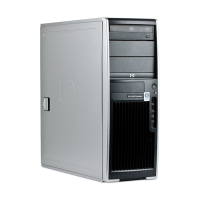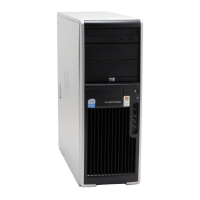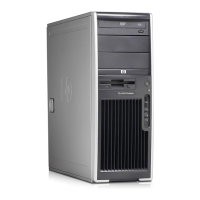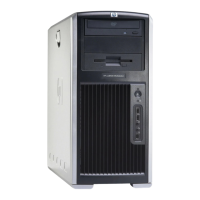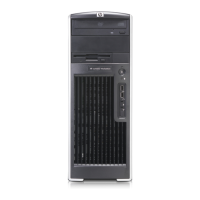SMART 155
Appendix A
In POST Messages Enabled mode: Press Ctrl+A when the “Press<Ctrl><A> for SCSI
Select
Utility”
message appears during POST.
In POST Messages Disabled mode: When the HP logo screen appears, press any key to exit the
logo screen. Immediately after exiting the logo screen, press Ctrl+A to access the SCSI
Select
utility.
A menu appears with the following options:
Configure/View Host Adapter Settings
SCSI Bus Interface Definitions
z Host Adapter SCSI ID
z SCSI Parity Checking
z Host Adapter SCSI Termination
Additional Options
z Boot Device Options
z SCSI Device Configuration
z Advanced Configuration Options
SCSI Disk Utilities
Lists all SCSI devices and SCSI ID numbers
NOTE For additional information about configuring POST message display status, refer to “Computer
Setup Menu” on page 37.
SMART
The SMART SCSI hard drives for HP workstations have built-in drive failure prediction that warns the
user or the network administrator of an impending failure or crash of the hard drive. SMART drives track
fault prediction and failure indication parameters, such as re-allocated sector count, spin retry count, and
calibration retry count. If the drive determines that a failure is imminent, it generates a fault alert.
Jumpers
All SCSI controllers require a unique SCSI ID (0–15) for each SCSI device installed.
The controller identifies a SCSI device by its SCSI ID number rather than its location. Moving a SCSI
device from one position to another on the SCSI chain does not affect communication between the
controller and the device.
The reserved and available SCSI ID numbers are displayed in the following list:
0 is reserved for the primary hard drive (not reserved for the primary hard drive on Linux).
7 is reserved for the SCSI controller.
1 through 6 and 8 through 15 are available for all other SCSI devices.
When 0 is used for the primary hard drive, set the second hard drive to 1, the third to 2, and so on.

